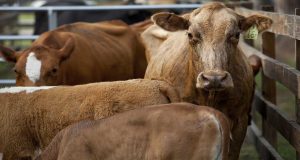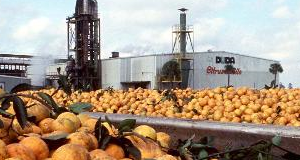Created to help growers and crop consultants, private homeowners, Master Gardeners, and the general public identify common arthropod pests and the damage they inflict, each field guide provides photos of the important life stages and crop damage associated with arthropod pests. The text highlights key general morphology and biology, distribution, and natural enemies. Written by Jeffrey Cluever and Hugh Smith, and published by the UF Department of Entomology and Nematology.
The following have been added to the existing series, http://edis.ifas.ufl.edu/topic_series_pest_identification_guides
Author: dihagan
University Zika Preparedness (UF website)
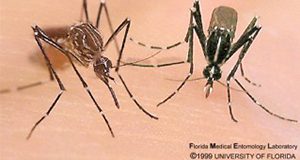
The University of Florida continues to monitor the spread of the Zika virus, working closely with local and state Department of Health officials. This UF website provides a centralized resource for current University of Florida information, including communications, prevention tips, resources, and research.
http://zika.ufl.edu
NOTICE: EDIS may be affected by computer outage this Saturday, August 13th
The EDIS website (http://edis.ifas.ufl.edu) may be down on Saturday starting at 8:00 a.m. due to maintenance on the power supply to the main server on UF's main campus. Although EDIS servers are among those impacted by the planned outage this Saturday, we are accelerating our migration schedule in the hopes that we can move off of the affected servers before the end of the week.
If the migration proves too complex to manage on short notice, the website will be down. Print ordering and publication approval (Workflow) sites, as well as the authoring tool, may be down as well.
New Featured Creatures: July 2016
- Emerald Ash Borer Agrilus planipennis Fairmaire (Insecta: Coleoptera: Buprestidae)
http://edis.ifas.ufl.edu/in1141 - Hercules Beetle Dynastes Hercules (Linnaeus, 1758) (Insecta: Coleoptera: Scarabaeidae)
http://edis.ifas.ufl.edu/in1142
New Featured Creatures: June 2016
- Bluegrass Billbug Sphenophorus parvulus Gyllenhal (Insecta: Coleoptera: Curculionidae: Dryophthorinae)
http://edis.ifas.ufl.edu/in1133 - Rustic Sphinx Manduca rustica (Fabricius) (Insecta: Lepidoptera: Sphingidae)
http://edis.ifas.ufl.edu/in1134
Estimated Costs and Regional Economic Impacts of the Oriental Fruit Fly (Bactrocera dorsalis) Outbreak in Miami-Dade County, Florida
Oriental fruit flies, very destructive pests of fruits, were first detected in the Redland area of Miami-Dade County on August 26, 2015, and as of January 2016, 165 flies had been captured. This triggered an eradication program and establishment of a quarantine area composed of agricultural operations and nonagricultural properties, such as residential and commercial areas. As part of the effort to eradicate the fruit fly, growers and packers in the quarantine area are required to sign a compliance agreement that outlines the procedures necessary for harvesting, handling, and postharvest processing of agricultural products that may serve as hosts for any life cycle of the fruit fly. This 12-page fact sheet written by Sergio Alvarez, Edward A. Evans, and Alan W. Hodges and published by the UF Food and Resource Economics Department provides estimates of the direct and indirect losses to Florida’s agriculture and related sectors as a result of the outbreak and ensuing quarantine and eradication programs.
http://edis.ifas.ufl.edu/fe988
2016 US Beef Cattle Market Outlook
US cattle markets have experienced a roller coaster ride over the last several years, with cattle prices have been supported by a declining US beef cow herd and strong beef demand. But a turning point in the US cattle industry occurred at the beginning of 2015. This 7-page fact sheet witten by Chris Prevatt and published by the UF Department of Food and Resource Economics includes highlights of the US cattle market’s cycle since 2004 and the estimated outlook for 2016, a brief analysis of the supply situation, food and forage conditions, demand and trade, competing meats, and the 2016 beef price outlook.
http://edis.ifas.ufl.edu/fe987
2014/15 Average Packing Charges for Florida Fresh Citrus
A survey of Florida fresh citrus packers was conducted in April 2015 to collect data on their packing charges during the 2014/15 season. A total of sixteen packinghouses participated in the survey, seven from the Interior region and nine from the Indian River region. The average of their responses was computed to obtain the estimates presented in this 4-page fact sheet was written by Ariel Singerman, and published by the UF Department of Food and Resource Economics, March 2016.
http://edis.ifas.ufl.edu/fe989
Citrus Greening (Huanglongbing; HLB) Blight and Tristeza Comparison Identification Sheet
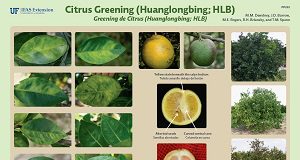 This document is a two-page illustrated identification sheet for Citrus Greening that includes a comparison chart for Citrus Greening, Blight and Tristeza.
This document is a two-page illustrated identification sheet for Citrus Greening that includes a comparison chart for Citrus Greening, Blight and Tristeza.
http://edis.ifas.ufl.edu/pp263
Temporary Food Plot Deterrents for Deer: Do They Work?
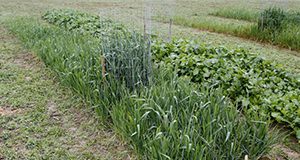
Many Floridians enjoy the opportunity to hunt, watch, or photograph white-tailed deer. Hunters and landowners often plant cool season forage plots both to attract wildlife and to provide a dependable food source. But where there is a high deer population or scarce food resources, deer may forage on food plots as soon as the plants emerge and before they become established. This fact sheet presents the results of research conducted at the UF/IFAS North Florida Research and Education Center in Quincy into the effectiveness of various strategies hunters and landowners can use to temporarily limit access to new food plots until the plants are well established and strong enough to attract and sustain hungry deer through the winter. Written by Holly Ober, Cheryl Mackowiak, and Ann Blount and published by the UF/IFAS Department of Wildlife Ecology and Conservation.
http://edis.ifas.ufl.edu/uw410
New and Revised Featured Creatures, April 2016
New & Revised Featured Creatures Publications
- Paper Wasp, Red Wasp (Suggested Common Names) Polistes carolina (L.) (Insecta: Hymenoptera: Vespidae)
- Broad-Tipped Conehead Katydid (suggested common name) Neoconocephalus triops (Linnaeus, 1758) (Orthoptera: Tettigoniidae: Conocephalinae)
- Viburnum Leaf Beetle Pyrrhalta viburni (Paykull) (Insecta: Coleoptera: Chrysomelidae)
- Strawberry Leafroller Ancylis comptana (Frölich) (Insecta: Lepidoptera: Tortricidae)
- Stable Fly Stomoxys calcitrans (L.) (Insecta: Diptera: Muscidae)
New Featured Creatures for January
Tobacco Thrips Frankliniella fusca (Hinds) (Insecta: Thysanoptera: Thripidae)
http://edis.ifas.ufl.edu/in1104
New Featured Creature publications added
The following publications are now available in EDIS:
Released November 9:
- Spicebush Swallowtail Papilio (Pterourus) Troilus Linnaeus 1758
- Lesser Wax Moth Achroia grisella Fabricius
- Oblong-Winged Katydid (suggested common name) Amblycorypha oblongifolia
- Florida Flower Thrips (suggested common name) Frankliniella bispinosa Morgan
- Laurelcherry Smoky Moth, Neoprocris floridana Tarmann 1984
- Pineapple Mealybug, Dysmicoccus brevipes (Cockerell)
Released November 10:
- Laurelcherry Smoky Moth, Neoprocris floridana Tarmann 1984
- Pineapple Mealybug, Dysmicoccus brevipes (Cockerell)
These publications on EDIS are alternate versions of pages published first on the Featured Creatures website.
Cooking with Fresh Herbs
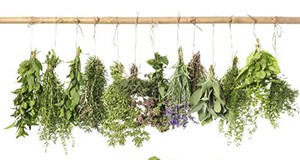 People worldwide are becoming more adventurous when cooking with fresh herbs. If you are just starting to use fresh herbs in your cooking or need a refresher, these tips for washing, storing, and cooking with herbs will lead you in the right direction. This 8-page fact sheet discusses the history of herbs, how to buy them fresh, how to wash and store them, dried herb blends, common herb and food combinations, and several recipes using herbs. Written by Emily Minton and Martha Maddox and published by the Department of Family, Youth, and Community Sciences, October 2015. (Photo credit: Credit: LiliGraphie/iStock/Thinkstock.com)
People worldwide are becoming more adventurous when cooking with fresh herbs. If you are just starting to use fresh herbs in your cooking or need a refresher, these tips for washing, storing, and cooking with herbs will lead you in the right direction. This 8-page fact sheet discusses the history of herbs, how to buy them fresh, how to wash and store them, dried herb blends, common herb and food combinations, and several recipes using herbs. Written by Emily Minton and Martha Maddox and published by the Department of Family, Youth, and Community Sciences, October 2015. (Photo credit: Credit: LiliGraphie/iStock/Thinkstock.com)
http://edis.ifas.ufl.edu/fy1209
Flatwoods Citrus Best Management Practice: Riser-Board Structures
 Water discharge structures are used to control water table levels and surface water levels in drainage and irrigation ditches within flatwoods citrus groves. The type of structure selected can significantly influence the quality of water discharged. With flashboard risers, water is forced to flow over the top board. This flow path creates a low current area toward the bottom, which facilitates the deposition of sediments and their accompanying nutrients or pesticides, essentially removing them from the discharges. Conversely, screw-gate structures do not create this dead-current zone. Since they open from the bottom, sediments are swept out along with the discharge water. Written by Chris Wilson, Liberta Scotto, Brian Boman, and Tim Gaver. Original publication date February 2002. Revised April 2012 and August 2015.
Water discharge structures are used to control water table levels and surface water levels in drainage and irrigation ditches within flatwoods citrus groves. The type of structure selected can significantly influence the quality of water discharged. With flashboard risers, water is forced to flow over the top board. This flow path creates a low current area toward the bottom, which facilitates the deposition of sediments and their accompanying nutrients or pesticides, essentially removing them from the discharges. Conversely, screw-gate structures do not create this dead-current zone. Since they open from the bottom, sediments are swept out along with the discharge water. Written by Chris Wilson, Liberta Scotto, Brian Boman, and Tim Gaver. Original publication date February 2002. Revised April 2012 and August 2015.
https://edis.ifas.ufl.edu/ss409
Flatwoods Citrus Best Management Practice: Soil Stabilization
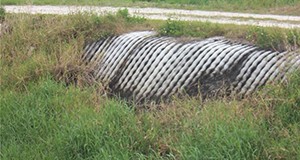
This best management practice describes stabilization practices for erosion-prone soils within flatwoods citrus groves. Significant amounts of soil may be deposited in drainage ditches and canals because of the erosion of grove soils. These deposited soils reduce the capacity for holding and transporting water. Plus, very small soil fractions may be suspended in discharge water then settle out in slower flowing areas and destroy submerged aquatic habitats, resulting in the loss of fish, invertebrate, and plant species important for healthy ecosystems. Fortunately, a variety of slope stabilization methods are available. This publication describes considerations for using plants for stabilization, or mulch-like materials. Written by P. Chris Wilson, Liberta Scotto, Brian Boman, and Tim Gaver. Original publication date March 2002. Revised April 2012 and August 2014. Reviewed August 2015.
http://edis.ifas.ufl.edu/ss408
Clavate Tortoise Beetle, Plagiometriona clavata (Fabricius)
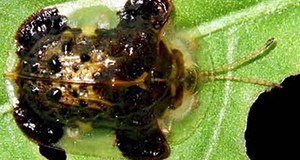
Plagiometriona clavata (Fabricius) is common and can be recognized easily by its general form and appearance. Written for Featured Creatures Collection by Robert E. Woodruff. Original publication date December 2006, revised August 2015. (Photo Credit: David Cappaert, www.forestryimages.org)
http://edis.ifas.ufl.edu/in710
Some Common Diseases of Pepper in Florida
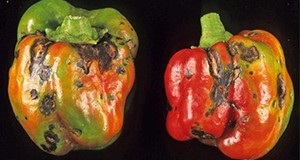
Pepper is an important commercial vegetable crop in Florida. During the months of November through May, the country is dependent on Florida for its supply of domestic fresh peppers. But disease problems often limit Florida pepper production. This fact sheet describes the symptoms and provides control recommendations for bacterial spot, phytophthora blight, wet rot, cercospora leaf spot, southern blight, blossom end rot, tobacco mosaic virus, aphid-transmitted viruses, and tomato spotted wilt virus (TSWV). Written by Gary Vallad, Pamela Roberts, Ken Pernezny, and Tom Kucharek. Originally published by the UF Department of Plant Pathology in March 1991, Revised September 2015. (Photo credit: Gerald Holmes, Bugwood.org, CC BY-NC 3.0 US). We would like to extend special thanks to professors emeriti Ken Pernezny and Tom Kucharek for interrupting their shuffleboard schedules to contribute to the revision of this publication.
http://edis.ifas.ufl.edu/vh054
General Recommendations for Fertilization of Turfgrasses on Florida Soils

In many neighborhoods, people envy the individual with the most beautiful lawn and think they cannot grow a lawn of equal quality. That is not necessarily true. A well-maintained lawn only requires some knowledge about fertilization, watering, pest control, and mowing. This publication provides basic information about fertilization. By far, the best approach to a proper fertilization program is to start with a soil test, but, if a soil test is not available, these guidelines can be used for a general turfgrass fertilization program. Original publication date May 1991. Revised August 2013 and August 2015.
http://edis.ifas.ufl.edu/lh014

